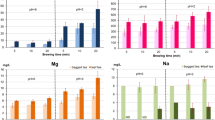Abstract
A microwave-assisted acid digestion procedure coupled with a graphite furnace atomic absorption method has been applied in the determination of aluminum (Al) in urine to verify the correlation of free forms of Al in tea infusions and urinary excretion of Al. Significant urinary Al excretion has been found in 24-h urine of four volunteers after tea drinking. However, the difference in amount of Al excretion in urine between the consumption of Oolong (black tea) and Long-Jin (green tea), each of them with unique Al contents and species, was not significant. These findings indicated that the high levels of free Al species in tea infusions did not result in significant change in urinary excretion of the metal, possibly owing to the transformation by ligands present in food and the gastrointestinal tract (GIT). However, it could not be assumed that there was no big difference in absorption of the metal in the human body if fractions of consumed Al retained in the body or excreted by bile or feces were considered.
Similar content being viewed by others
References
H. Matsumoto, E. Hirasawa, S. Morimura, and E. Takahashi, Localization of aluminium in tea leaves.Plant Cell Physiol. 17, 627–631 (1976).
A. M. Goriat and R. D. Gillard, Beware the cups that cheer,Nature 321, 570 (1986).
K. R. Koch, M. A. Bruno Pougndt, S. De Villiers, and F. Nonteagudo, Increased urinary excretion of Al after drinking tea.Nature 333, 123 (1988).
M. J. Baxer, J. A. Burrel, H. M. Crews, and R. C. Massey, Aluminium in infant formulae and tea and leaching during cooking, inAluminium in Food and the Environment, Royal Society of Chemistry, Cambridge, pp. 77–87 (1989).
R. Weberg and A. Berstad, Gastrointestinal absorption of aluminium form single doses of aluminium containing antacids in man.Eur. J. Clin. Invest. 16, 428–432 (1986).
P. French, M. J. Gardner, and A. M. Gunn, Dietary aluminium and Alzheimer’s disease.Food Chem. Toxicol. 27, 495–496 (1989).
S. J. Fairweather-Tait, Z. Piper, S. J. A. Fatemi, and G. R. Moore, The effect of tea on iron and aluminium metabolism in the rat.Br. J. Nutr. 65, 61–68 (1991).
P. N. Drewitt, K. R. Butterworth, C. D. Springall, and S. R. Moorhouse, Plasma levels of aluminium after tea ingestion in healthy volunteers,Food Chem. Toxicol. 31, 19–23 (1993).
J. J. Powell, S. M. Greenfield, H. G. Parkes, J. K. Nicholson, and R. P. H. Thompson, Gastro-intestinal availability of aluminium from tea.Food Chem. Toxicol. 31, 449–454 (1993).
T. Natgata, M. Hayatsu, and N. Kosuge, Identification of aluminium forms in tea leaves by27Al NMR.Phytochemistry 31, 1215–1218 (1992).
L. M. W. Owen, H. M. Crews, and R. C. Massey, Aluminium in tea: ESC-ICP-MS speciation studies of infusions and simulated gastrointestinal digests.Chem. Speciation and Bioavailability 4, 89–96 (1992).
T. P. Flaten and M. Ødegard, Tea, aluminium and Alzheimer’s disease.Food Chem. Toxicol. 26, 959–960 (1988).
C. Y. Zhou, J. Wu, H. Chi, M. K. Wong, L. L. Koh, and Y. C. Wee, The behavior of leached aluminium in tea infusions.Sci. Total Environ. 177, 9–16 (1995).
J. L. Greger and M. J. Baier, Excretion and retention of low or moderate levels of aluminium by human subjects,Food Chem. Toxicol. 21, 473–477 (1983).
A. J. Blotcky, D. Hobson, J. A. Leffler, E. P. Rack, and R. R. Recker, Determination of trace aluminum in urine by neutron activation analysis.Anal. Chem. 48, 1084–1088 (1976).
J. E. Gorsky and A. A. Dietz, Determination of aluminum in biological samples by atomic absorption spectrophotometry with a graphite furnace,Clin. Chem. 24, 1485–1490 (1978).
W. D. Kaehny, A. P. Hegg, and A. C. Alfrey, Gastrointestinal absorption of aluminum from aluminum containing antacids.N. Engl. J. Med. 296, 1389–1390 (1977).
R. R. Recker, A. J. Blotcky, J. A. Leffler, and E. P. Rack, Evidence for aluminum absorption from the gastrointestinal tract and bone deposition by aluminum carbonate ingestion with normal renal function.J. Lab. Clin. Med. 90, 810–815 (1977).
J. E. Gorsky, A. A. Dietz, H. Spencer, and D. Osis, Metabolic balance of aluminum studied in six men.Clin. Chem. 25, 1739–1743 (1979).
P. Allain, Y. Mauras, N. Krari, J. Duchier, A. Cournot, and J. Larcheveque, Plasma and urine aluminium concentrations in healthy subjects after administration of sucralfate,Br. J. Clin. Pharmacol. 29, 391–395 (1990).
C. J. Lote and H. Saunders, Aluminum: gastrointestinal absorption and renal excretion,Clin. Sci. 81, 289–295 (1991).
P. O. Ganrot, Metabolism and possible health effects of aluminum,Environ. Health Perspect. 65, 363–441 (1986).
W. W. K. Koo and L. A. Kaplan, Aluminum and bone disorders: with specific reference to aluminum contamination of infant nutrients,J. Am. Coll. Nutr. 7, 199–214 (1988).
L.-G., Danielsson, A. Sparén, and A. W. Glynn, Aluminium fractionation in a simulated rat stomach: anin vitro study,Analyst 120, 713–720 (1995).
A. W. Glynn, A. Sparén, L.-G. Danielsson, G. Haegglund, and L. Lorhem, Bioabailability of labile aluminium in acidic drinking water: a study in the rat.Food Chem. Toxicol. 33, 403–408 (1995).
A. C. Alfrey, Physiology of aluminium in man, inAluminium and Health: A Critical Review, H. J. Gitelman, ed., Marcel Dekker, New York, pp. 101–124 (1989).
Author information
Authors and Affiliations
Rights and permissions
About this article
Cite this article
Wu, J., Zhou, C.Y., Wong, M.K. et al. Urine levels of aluminum after drinking tea. Biol Trace Elem Res 57, 271–280 (1997). https://doi.org/10.1007/BF02785295
Received:
Revised:
Accepted:
Issue Date:
DOI: https://doi.org/10.1007/BF02785295




